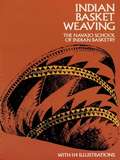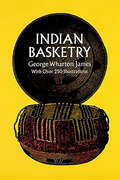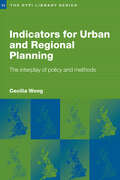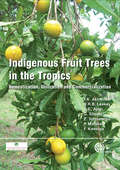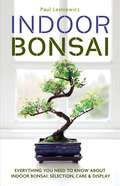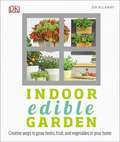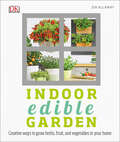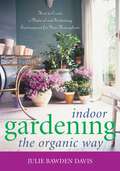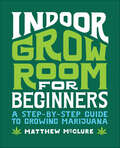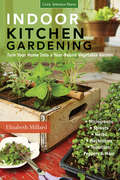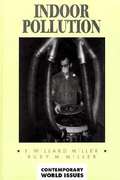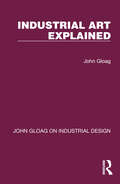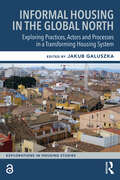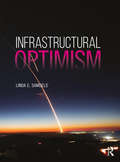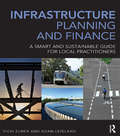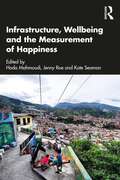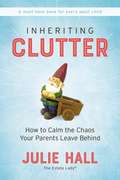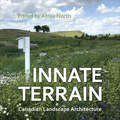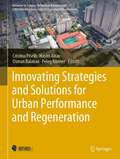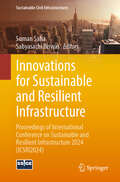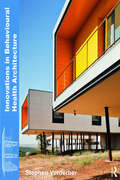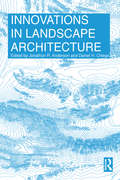- Table View
- List View
Indian Basket Weaving
by Navajo School of Indian BasketryThe methods of Indian basket weaving explained in this excellent manual are the very ones employed by native practitioners of the craft. members of the Navajo School of Basketry have set down their secrets in clear and simple language, enabling even the beginner to create work that can rival theirs in grace, design, and usefulness.Beginning with basic techniques, choice of materials, preparation of the reed, splicing, the introduction of color, principles and methods of design, shaping the basket and weaves from many cultures, such as Lazy Squaw, Mariposa, Taos, Samoan, Klikitat, and Shilo, each accompanied by specific instructions. There are suggestions for the weaving of shells, beads, feathers, fan palms, date palms, and even pine needles, and recipes for the preparation of dyes.Examples of each type of basket are illustrated by photographs, often taken from more than one angle so that the bottom can be seen as well as the top and sides. Close-up photography of the various types of stitching, especially at the crucial stage of beginning the basket, is an invaluable aid to the weaver. In addition, the authors have provided line drawings which are exceptionally clear magnifications of the various weave patterns.Anyone who follows the lessons contained in this book will have a knowledge of basketry unattainable in any other way. They are so lucid and complete that the amateur as well as the experienced weaver will be able to manufacture baskets distinguishable from authentic native articles only in that they were not woven by Indians. For those who merely seek a broader knowledge of American Indian arts, the book provides a comprehensive introduction to the subject of basketry.
Indian Basketry
by George W. JamesSince it first publication in 1901, this pioneering study by George Wharton James, once a leading collector and authority, has become a valuable source book for American Indian basketry. From Poma mush baskets to Paiute dicing trays, Indian Basketry traces the origin, development, and fundamental principles of Indian basket designs for the major tribal units in Southwestern United States and Pacific Coast, with occasional comments on the basket weaving of a number of other North American tribes.Author of several books on the Southwest, George James has used his extensive experience in the field to compile indispensable information (much gathered directly through interviews with Indian basketmakers) covering nearly every aspect of Indian basketry: esthetics, designs, dyes, and coloration, weaving and stitching techniques (including the bamtush and dah-lah methods), basket types, tribal variation, and functional considerations, offering clear instructions for those who may be interested in reproducing these ancient American crafts. James also includes a description of various native weaving materials such as pine root, bark, sumac, willow, twigs, fern stalks, grass and palm fronds, with suggestions regarding the ways in which the Indians wove shells, feathers, beads, leather, and pine needles into their basket designs.The book is a valuable aid for the artist, designer, and craftsman, or even for the beginner, who may wish to re-create authentic and often extinct basket forms and decorative motifs. It is also most useful to the collector, cultural historians, ethnologist, scholar, or buff, who desires to know more about specific aspects of Indian basketry, or about Indian arts in general. As an important contribution to the historiography of American Indian culture, this may be one of the most practical Indian basketry books that you could own.
Indicators for Urban and Regional Planning: The Interplay of Policy and Methods (RTPI Library Series)
by Cecilia WongThis book focuses on the measurement and utilisation of quantitative indicators in the urban and regional planning fields. There has been a resurgence of academic and policy interest in using indicators to inform planning, partly in response to the current government's information intensive approach to decision-making. The content of the book falls into three broad sections: indicators usage and policy-making; methodological and conception issues; and case studies of policy indicators.
Indigenous Fruit Trees in the Tropics: Domestication, Utilization and Commercialization
by Festus K. Akinnifesi Oluyede C. Ajayi Patrick Matakala Freddie R. Kwesiga Gudeta Sileshi Zac Tchoundjeu Roger R. B. LeakeyFocusing on livestock production systems, this comprehensive text addresses how the growing diversity of global food demands will be met in the future, providing insights into new and emerging scientific areas and the implications for addressing global drivers for change.
Indoor Bonsai
by Paul Lesniewicz"Excellent guide...with specifics on individual plants." - The New York Times.A bonsai is a miniature tree. Grown in a shallow dish, it resembles larger trees in all respects except size, and lives to an equally old age.The conventional bonsai requires a site in the open air where the plant is exposed to the sun, wind and rain in order to develop and remain healthy. In this book, however, Paul Lesniewicz looks at those species that can successfully be kept indoors all year round. He explores a vast variety of bonsai trees, including mini versions, which are only 3-6 inches tall, for those who are really lacking in space.Indoor Bonsai includes sections such as choosing a plant or growing it from seed, planting, general care, pests and diseases, shaping, wiring and pruning, and many other aspects, all explained in simple and straightforward terms. Advice is accompanied by step-by-step illustrations and spectacular colour photography throughout, to help you choose and care for your bonsai tree.Paul's guidance is not a one-size-fits-all approach; his sensible and easy-to-follow advice will help each gardener to create their own individual work of art.
Indoor Bonsai
by Paul Lesniewicz"Excellent guide...with specifics on individual plants." - The New York Times. A bonsai is a miniature tree. Grown in a shallow dish, it resembles larger trees in all respects except size, and lives to an equally old age.The conventional bonsai requires a site in the open air where the plant is exposed to the sun, wind and rain in order to develop and remain healthy. In this book, however, Paul Lesniewicz looks at those species that can successfully be kept indoors all year round. He explores a vast variety of bonsai trees, including mini versions, which are only 3-6 inches tall, for those who are really lacking in space.Indoor Bonsai includes sections such as choosing a plant or growing it from seed, planting, general care, pests and diseases, shaping, wiring and pruning, and many other aspects, all explained in simple and straightforward terms. Advice is accompanied by step-by-step illustrations and spectacular colour photography throughout, to help you choose and care for your bonsai tree.Paul's guidance is not a one-size-fits-all approach; his sensible and easy-to-follow advice will help each gardener to create their own individual work of art.
Indoor Edible Garden
by Janette Marshall Zia AllawayMake the most of your space, from balconies and windowsills to countertops, walls, and even ceilings, to grow herbs, vegetables, and flowers in your home that look amazing and taste even better. Featuring 28 innovative step-by-step projects, Indoor Edible Garden is a highly visual guide full of practical tips and stylish ideas for how to create edible indoor gardens using whatever space you have available. Use your space and light in clever ways, brightening your home with unique living decorations. Inspiring from the start, this book shows off its lush garden projects through beautiful design and full-color photographs. Reference more than 30 profiles of the top herbs, edible flowers, fruiting plants, and vegetables. Follow DIY project templates to grow your gardens into beautiful home decor. The step-by-step instructions include how to create a hanging chili and basil ball, how to grown your own tea leaves, how to sprout microgreens in cupcake liners, and more. Plus, this guide also includes straightforward explanations of scientific methods such as artificial lighting and hydroponics and key techniques for planting, drainage, and harvesting. Indoor Edible Garden helps create stunning and edible home decor so your living space will be fruitful--and beautiful--all year round.
Indoor Edible Garden: Creative Ways to Grow Herbs, Fruits, and Vegetables in Your Home
by Zia AllawayMake the most of your space, from balconies and windowsills to countertops, walls, and even ceilings, to grow herbs, vegetables, and flowers in your home that look amazing and taste even better.Featuring 28 innovative step-by-step projects, Indoor Edible Garden is a highly visual guide full of practical tips and stylish ideas for how to create edible indoor gardens using whatever space you have available. Use your space and light in clever ways, brightening your home with unique living decorations. Inspiring from the start, this book shows off its lush garden projects through beautiful design and full-color photographs.Reference more than 30 profiles of the top herbs, edible flowers, fruiting plants, and vegetables. Follow DIY project templates to grow your gardens into beautiful home decor. The step-by-step instructions include how to create a hanging chili and basil ball, how to grown your own tea leaves, how to sprout microgreens in cupcake liners, and more. Plus, this guide also includes straightforward explanations of scientific methods such as artificial lighting and hydroponics and key techniques for planting, drainage, and harvesting.Indoor Edible Garden helps create stunning and edible home decor so your living space will be fruitful—and beautiful—all year round.
Indoor Gardening the Organic Way: How to Create a Natural and Sustaining Environment for Your Houseplants
by Julie Bawden DavisGardening organically outdoors is prevalent in most horticultural circles these days, but what about gardening indoors? Many gardeners still use harsh synthetic chemical fertilizers and pesticides when growing plants in their homes. How can we choose to eat organic foods, buy natural personal-care products, clean our indoor air, and yet still blast our poor houseplants with toxic chemicals? It is time to put down that spray bottle. Going organic with houseplants is not only possible-the results are amazing! Author Julie Bawden Davis brings us Indoor Gardening the Organic Way, a definitive guide to growing houseplants organically. From the dirt on mulch to eco-friendly ways to handle plant pests, Davis has provided this essential resource for novice and experienced gardeners alike. When you learn the specialized rules of gardening organically indoors, you'll soon reap the benefits of robust houseplants that will impress visitors and make your indoor environment a healthier place to be.
Indoor Grow Room for Beginners: A Step-By-Step Guide to Growing Marijuana
by Matthew McClureGrow your own marijuana indoors with help from this comprehensive guideEven if you have no experience, growing marijuana at home is easy once you learn the basics. This step-by-step guide provides novice growers with simple instructions on how to set up an indoor growing space and nurture high-quality buds. Find advice for each stage of the process, from choosing the right space, equipment, and strains, to planting, caring for, and cultivating a thriving crop.In this guide to growing marijuana indoors, you'll find:An overview of the basics—Explore the anatomy and life cycle of the cannabis plant, the four fundamentals of growing marijuana, and common myths and misconceptions.The complete setup—Learn the pros and cons of growing marijuana in a closet, tent, or grow room, and get comprehensive instructions and equipment lists that work for any indoor setting.Visual guidance—Detailed diagrams and illustrations clearly explain complex concepts so you can grow cannabis at home with confidence.Tips for growing the best buds—Discover at-a-glance tables that make it easy to harvest hearty, seedless buds, with information on how to rig lighting, lay out your space, maintain proper nutrients, control pests, and prune your plants.Discover the joy of growing marijuana with this comprehensive guide to indoor cultivation for beginners.
Indoor Kitchen Gardening: Turn Your Home Into a Year-Round Vegetable Garden
by Elizabeth MillardAs featured in The New York Times, grow amazing, fresh, organic produce in your own home with this critically acclaimed indoor gardening manual.It takes just a few dollars and a few days for you to start enjoying fresh, healthy produce grown indoors. Imagine serving a home-cooked meal highlighted with beet, arugula, and broccoli microgreens grown right in your kitchen, accompanied by sautéed winecap mushrooms grown in a box of sawdust in your basement. Explore the expansive new world of growing and eating that can be discovered with the help of Indoor Kitchen Gardening.Author and Bossy Acres CSA co-owner Elizabeth Millard teaches you how to grow microgreens, sprouts, herbs, mushrooms, tomatoes, peppers, and more—all inside your own home, where you won’t have to worry about seasonal changes or weather conditions. In this guide, you will find: ·An introduction to growing edibles indoors, from defining your goals and choosing a space, containers, soil, and grow lights to troubleshooting common problems.·Guidance for growing crops perfectly suited to an indoor environment and that often have quick seed-to-harvest timeframes, such as microgreens, shoots, herbs, wheatgrass, sprouts, and mushrooms. ·Guidance for growing crops with shallow root systems that grow well indoors—such as radishes, carrots, lettuces, and tomatoes. ·Plenty of cheerleading to encourage your sense of adventure.Filled with photos and more than two hundred pages of do-it-yourself in-home gardening information and projects, Indoor Kitchen Gardening is your gateway to this exciting new growing method.“Well-written, clearly illustrated and full of personality.” —Northern Gardener“This is a great book for both beginners and seasoned gardeners.” —The American Gardener Magazine from The American Horticultural Society
Indoor Pollution
by E. Willard Miller Ruby M. MillerThe presence of polluted air in the home from heating and cooking food is as old as civilization itself. In modern times the general public only became aware of the health hazards when the number of household chemicals increased dramatically in the twentieth century. Few governmental regulations have been passed to regulate the home environment. The concept that the home is a man's castle has delayed the passing of governmental regulations that control the quality of the indoor environment. Standards are, however, being established by many private organizations.
Industrial Art Explained (John Gloag On Industrial Design Ser.)
by John GloagOriginally published in 1934 this book became recognised as one of the principal standard works on industrial design and industrial architecture. The chapters explain the complete operation, character and background history of industrial art, its relation to architecture, materials, industrial production and retail distribution. It is fully illustrated with line drawings and photographs.
Informal Housing in the Global North: Exploring Practices, Actors and Processes in a Transforming Housing System (Explorations in Housing Studies)
by Jakub GaluszkaInformal Housing in the Global North proposes analytical and conceptual approaches to investigate the progressing ‘informalisation’ of contemporary housing in the Global North and beyond.Amidst the ongoing housing crisis, the reading of informalities in the so-called North has increasingly disrupted the conventional understanding of local cities as fully regulated, well-structured and formal. By juxtaposing contested, successful and ‘under- the- radar’ ordinary housing phenomena across various income levels, this volume seeks to unpack and document the embeddedness of informality in mid- and high-income cities. This investigation reveals the pervasive and hybrid nature of local housing systems, in which formal frameworks defining modes of utilising spaces and architectural design are continuously reinterpreted by users, public sector actors and market entities alike. It reflects on everyday housing pathways and the agency of those who, by preference or necessity, engage with solutions conventionally labelled as informal.This book will be of interest to scholars and students of housing studies, planning, architecture and urban sociology as well as practitioners working in the field of housing.
Infrastructural Optimism
by Linda C. SamuelsInfrastructural Optimism investigates a new kind of twenty-first-century infrastructure, one that encourages a broader understanding of the interdependence of resources and agencies, recognizes a rightfully accelerated need for equitable access and distribution, and prioritizes rising environmental diligence across the design disciplines. Bringing together urban history, case studies, and speculative design propositions, the book explores and defines infrastructure as the basis for a new form of urbanism, emerging from the intersection of architecture, landscape architecture, and urban design. In defining this new infrastructure, the book introduces new dynamic and holistic performance metrics focused on "measuring what matters" over growth for the sake of growth and twelve criteria that define next generation infrastructure. By shifting the focus of infrastructure – our largest public realm – to environmental symbiosis and quality of life for all, design becomes a catalytic component in creating a more beautiful, productive, and optimistic future with Infrastructural Urbanism as its driver. Infrastructural Optimism will be invaluable to design, non-profit and agency professionals, and faculty and students in the fields of architecture, landscape architecture, and urban design, working in partnership with engineers, hydrologists, ecologists, urban planners, community members, and others who shape the built environment through the expanded field of infrastructure.
Infrastructure Planning and Finance: A Smart and Sustainable Guide
by Vicki Elmer Adam LeiglandInfrastructure Planning and Finance is a non-technical guide to the engineering, planning, and financing of major infrastucture projects in the United States, providing both step-by-step guidance, and a broad overview of the technical, political, and economic challenges of creating lasting infrastructure in the 21st Century. Infrastructure Planning and Finance is designed for the local practitioner or student who wants to learn the basics of how to develop an infrastructure plan, a program, or an individual infrastructure project. A team of authors with experience in public works, planning, and city government explain the history and economic environment of infrastructure and capital planning, addressing common tools like the comprehensive plan, sustainability plans, and local regulations. The book guides readers through the preparation and development of comprehensive plans and infrastructure projects, and through major funding mechanisms, from bonds, user fees, and impact fees to privatization and competition. The rest of the book describes the individual infrastructure systems: their elements, current issues and a 'how-to-do-it' section that covers the system and the comprehensive plan, development regulations and how it can be financed. Innovations such as decentralization, green and blue-green technologies are described as well as local policy actions to achieve a more sustainable city are also addressed. Chapters include water, wastewater, solid waste, streets, transportation, airports, ports, community facilities, parks, schools, energy and telecommunications. Attention is given to how local policies can ensure a sustainable and climate friendly infrastructure system, and how planning for them can be integrated across disciplines.
Infrastructure, Wellbeing and the Measurement of Happiness
by Roe Jenny Seaman Kate Mahmoudi HodaThis book takes an interdisciplinary approach to our understanding of infrastructure, and it’s influence on happiness and wellbeing, by examining the concept from economic, human development, architectural, urban planning, psychological, and ethical points of view. Providing insights from both research and practice the volume discusses how to develop happier cities and improve urban infrastructure for the wellbeing of the whole population. The book puts forth the argument that it is only in understanding the true nature of infrastructure’s reach – how it connects, supports, and enlivens human beings – that we can truly begin to understand infrastructure’s possibilities. It connects infrastructure to that most elusive of human qualities – happiness – examining the way infrastructure is fundamentally tied to human values and human well-being. The book seeks to suggest novel approaches, identify outmoded undertakings, and define new possibilities in order to maximize infrastructure’s impact for all people – with a focus on diversity, inclusion and equity. In seeking to define infrastructure broadly and examine its possibilities systematically this book brings together theory and evidence from multiple disciplinary perspectives including, sociology, urban studies, architecture, economics, and public health in order to advance a startling claim – that our lives, and the lives of others, can be substantively improved by greater adhesion to the principles and practices of infrastructure design for happiness and wellbeing.
Inheriting Clutter: How to Calm the Chaos Your Parents Leave Behind
by Julie HallEveryday hundreds of adult children become middle-aged orphans when their elderly parents pass away, leaving behind more than just memories.You&’ve heard the horror stories: arguments over stuff, an inheritance lost forever when easily deceived parents are scammed, siblings estranged, an adult heir taken from daily responsibilities for months because of the enormous task of clearing out a childhood home. It doesn&’t have to be that way.The Estate Lady, professional estate liquidator Julie Hall, knows what to do. Whether your parents are still living or you&’re caught in the middle of a crisis, Inheriting Clutter: How to Calm the Chaos Your Parents Leave Behind has solutions. Hall provides trustworthy counsel on how to:Divide your parents&’ estate with peace of mindMinimize fighting with siblings during the estate settlement processClear out the family home in thirty days or lessIdentify potential items of value in the homeHave &“that conversation&” with your parentsPrepare your own children for the futureThe Estate Lady offers guidance for any executor, heir, or beneficiary, sharing some of her most fascinating stories as well as helpful checklists of the things that need to be done now and at the time of your loss.Inheriting Clutter gives you practical, effective steps for liquidating and distributing your parents&’ assets in a way that both honors them and promotes family harmony for generations to come.
Innate Terrain: Canadian Landscape Architecture
by Alissa NorthInnate Terrain addresses the varied perceptions of Canada’s natural terrain, framing the discussion in the context of landscapes designed by Canadian landscape architects. This edited collection draws on contemporary works to theorize a distinct approach practiced by Canadian landscape architects from across the country. The essays – authored by Canadian scholars and practitioners, some of whom are Indigenous or have worked closely with Indigenous communities – are united by the argument that Canadian landscape architecture is intrinsically linked to the innate qualities of the surrounding terrain. Beautifully illustrated, Innate Terrain aims to capture distinct regional qualities that are rooted in the broader context of the Canadian landscape.
Innovating Strategies and Solutions for Urban Performance and Regeneration (Advances in Science, Technology & Innovation)
by Haşim Altan Cristina Piselli Osman Balaban Peleg KremerThis book focuses on enhancing urban regeneration performance and strategies that pave the way toward sustainable urban development models and solutions. The book at hand thoroughly examines the latest studies on the regeneration of urban areas and attempts at alleviating the negative impacts associated with high population density and urban heat effects. It gathers contributions that combine theoretical reflections and international case studies on urban regeneration and transformation with the single goal of tackling existing social and economic imbalances and developing new solutions. The primary audience of this book will be from the field of architecture and urban planning, offering new insights on how to address the myriad of problems that our cities are facing.
Innovations for Sustainable and Resilient Infrastructure: Proceedings of International Conference on Sustainable and Resilient Infrastructure 2024 (ICSRI2024) (Sustainable Civil Infrastructures)
by Sabyasachi Biswas Suman SahaThis book aims to provide innovative solutions to the various problems faced during the infrastructural development across the globe. The book is highly focused on the following topics, but not limited to: innovative technologies in infrastructure, sustainable materials, smart cities, climate resilient infrastructures, and applications of AI and ML in infrastructure development. The contributions presented in this volume reflect the extensive research and innovative thinking of researchers and practitioners dedicated to shaping the future of sustainable infrastructure. It is anticipated that the knowledge shared through this conference proceedins book will inspire further advancements and collaborative efforts toward building sustainable and resilient infrastructure globally.
Innovations in Behavioural Health Architecture
by Stephen VerderberInnovations in Behavioural Health Architecture is the most comprehensive book written on this topic in more than 40 years. It examines the ways in which healthcare architecture can contribute, as a highly valued informational and reference source, to the provision of psychiatric and addictive disorder treatment in communities around the world. It provides an overview of the need for a new generation of progressively planned and designed treatment centres – both inpatient and outpatient care environments – and the advantages, challenges, and opportunities associated with meeting the burgeoning need for treatment settings of this type. Additional chapters address the specifics of geriatric psychiatry and its architectural ramifications in light of the rapid aging of societies globally and provide a comprehensive compendium of planning and design considerations for these places in both inpatient and outpatient care contexts. Finally, the book presents an expansive and fully illustrated set of international case studies that express state-of-the-art advancements in architecture for behavioural healthcare.
Innovations in Landscape Architecture
by Jonathon R. Anderson Daniel H. OrtegaThis inspiring and thought-provoking book explores how recent innovations in landscape architecture have uniquely positioned the practice to address complex issues and technologies that affect our built environment. The changing and expanding nature of "landscape" make it more important than ever for landscape architects to seek innovation as a critical component in the forward development of a contemporary profession that merges expansive ideas and applications. The editors bring together leading contributors who are experts in new and pioneering approaches and technologies within the fields of academic and professional landscape architecture. The chapters explore digital technology, design processes and theoretical queries that shape the contemporary practice of landscape architecture. Topics covered include: Digital design Fabrication and prototyping Emerging technology Visualization of data System theory Concluding the book are case studies looking at the work of two landscape firms (PEG and MYKD) and two academic departments (Illinois Institute of Technology and the Rhode Island School of Design), which together show the novel and exciting directions that landscape is already going in.
Innovative Approaches to Researching Landscape and Health: Open Space: People Space 2
by Simon Bell Catharine Ward Thompson Peter AspinallOur modern lifestyles often cause us to spend more time sitting behind a desk than being active outdoors. At the same time, our general health is deteriorating. The alarming rise in obesity, sedentary lifestyles and mental ill-health across the developed world has resulted in an urgent desire to understand how the environment, in particular the outdoor environment, influences health. This book addresses the growing interest in salutogenic environments - landscapes that support healthy lifestyles and promote well-being – and the need for innovative methods to research them. Drawing on multidisciplinary approaches from environmental psychology, health sciences, urban design, landscape architecture and horticulture, it questions how future research can be better targeted to inform policy and practice in health promotion. The contributing authors are international experts in researching landscape, health and the environment, drawn together by OPENspace directors who have a unique reputation in this area. This pioneering book is a valuable resource for postgraduate researchers and practitioners in both environmental and health studies.
Innovative Cities
by James SimmieInnovative Cities presents a unique international comparison of innovation in Amsterdam, London, Milan, Paris and Stuttgart. Based on research funded by the ESRC program on 'Cities: Competitiveness and Cohesion', it compares and contrasts the reasons why these sites are among the top ten innovative cities in Europe. Innovation is one of the key driving forces of economic growth in modern economies.The research reported here takes a careful and directly comparable look at what characteristics and conditions in the five cities have led to the flourishing of innovation in them. Researchers with detailed local knowledge have applied the same analytical tools and survey techniques to investigating this question and the result present a unique international comparison of innovation in the five cities.
